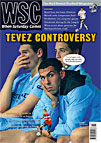 Cornwall’s flagship team have risen quickly through the football pyramid. James Taylor reports on the challenges Truro City now face
Cornwall’s flagship team have risen quickly through the football pyramid. James Taylor reports on the challenges Truro City now face
Cornwall has never had a Football League team but this season sees Truro City playing in Blue Square South, just two steps below League Two. Since chairman and local property magnate Kevin Heaney started investing in 2004, the club have won five promotions in six seasons, collecting an FA Vase at Wembley along the way and the nickname of “the Chelsea of non-League”.
Investment aside, this is a major achievement in football terms. A small squad has been skilfully managed with the core of the team staying together for several years. League experience has helped, most recently with the addition of ex-Fulham and Plymouth striker Barry Hayles. The Blue Square South is the biggest step up so far. Truro are facing teams that are mentally tougher and are more tactically flexible. The team must also face jaw-dropping travel distances even within a regionalised league. The 279 miles to Dover, for example, put in a north-south perspective is an equivalent journey to Sunderland to Southampton.
Truro began the season with three straight wins, followed by four straight defeats. I saw them play their next match, at Boreham Wood on September 13. Truro started brightly and scored early through ex-Plymouth striker Marcus Martin, but were pegged back by a home equaliser. After being temporarily distracted by the noise of a suburban hedge strimmer, Truro fans confused the locals with a rendition of “You dirty northern bastards”.
With minutes remaining, Scott Walker smashed a free-kick into the top corner to win the game. Players and fans celebrated together and a corner was turned. Truro followed that victory with four points in the next three games to leave them comfortably in mid-table. Morale seems high among the players who are currently holding a beard-growing competition.
Consolidation in the Blue Square South would be a reasonable target, but significant challenges lie ahead. This season has been overshadowed by Heaney being linked to a consortium proposing to takeover at Plymouth Argyle. Truro City were also recently served a winding-up order by HM Revenue & Customs for unpaid tax, due to be heard in October. Heaney claims that everything is in order and that HRMC are, typically, using a big stick to hit a small club, with his attempted takeover at Plymouth an excuse to take a hard line. Detractors think that Heaney and the club have got their comeuppance and the rug is about to be pulled from under their feet.
Truro’s ground, Treyew Road, does not meet Conference standards and in the long term the club needs to build their fanbase to reduce dependence on Heaney’s money. A focal point for this could be a new 16,000-seat “Stadium for Cornwall” in Truro, involving a groundshare with Cornish Pirates rugby team. Although Cornwall is rugby country, Truro were cheered on by 15,000 at Wembley. Passion for Cornish identity runs deep, as evidenced by a local radio phone-in during the 2010 World Cup on which team callers would support – it was a given that it wouldn’t be England.
Many non-Cornish fans seem to have a soft spot for the club. In the away end at Boreham Wood was a family from Coventry who now follow Truro, having once attended a game on holiday in Cornwall, and a fan from Barnet who follows the club because his mum has a holiday cottage near Newquay. Truro could do more to attract some of the five million tourists visiting the county every year.
Truro City are at a crossroads. The players have done the club proud and support is growing, but the club’s chairman and finances are under scrutiny. If the investment continues, Truro will continue to be a flagship football team for Cornwall, but they could yet fall back down just as fast. It is one thing being the current “Chelsea of non-League”, what concerns fans is that they may become another Rushden and Diamonds.
From WSC 297 November 2011